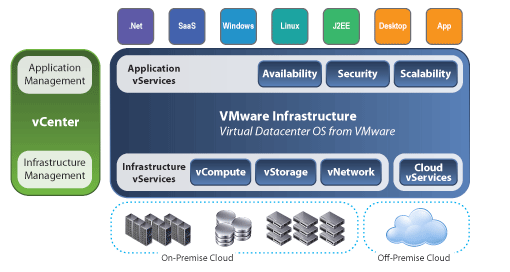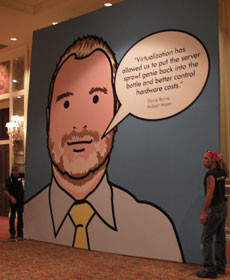Many of the 14.000 attendants to VMworld will be happy to learn they are not going to be out of their jobs soon. Especially with cloud providers threatening to reduce corporate IT departments, completely virtualized datacenters are believed to be the future. VMware intends to keep those datacenters under their corporate client’s control on standardized X86 hardware.
(Update: link to the ‘Virtual Datacenter OS for VMware‘ product page and its Cloud vServices)
(Update 2: the link to the official press release, more comments below and a mention on Between The Lines)
Will vCloud be introduced as a cure against outsourcing to third party data centers? It is VMware’s aspiration to offer every business the flexible infrastructure associated with Amazon, Google and Salesforce. However without the need to offer excess computing power to external clients. VMware is not alone with this vision as this is very close to the network grail George Kurian at Cisco envisions:
What is most important in the virtualization world is to not to think about your data center as traditional silos of storage, server, network, firewall, application… We need to bring virtualization into the network… If you think about networking speeds and latency getting faster and lower respectively, you can, in essence, really extend virtualization to all aspects of IT systems. Down the road we see the opportunity to drive things like processor virtualization, memory virtualization, as interconnect speeds go up dramatically and latencies reduce over the next two to three years.
VMware’s new CEO Paul Maritz (who was an early believer in cloud computing) will use this vCloud announcement (not a product release) to warm up the 14,000 people expected at its annual conference in Las Vegas this week. According to a well researched article by Patrick Thibodeau over at Computer World:
… the planned cornerstone product is VMware’s Virtual Datacenter Operating System (VDC-OS) for managing the underlying systems, or “internal cloud.” Desktops and laptops are part of this virtualization umbrella, with their operating systems running in a virtual machine on the client computer that is managed back from the data center. VMware also wants to make it possible for IT managers to seamlessly tap into the resources of third-party hosting providers in the same way they can now move server resources inside their data center. It calls this new technology vCloud. VMware’s product set, including its VDC-OS, is limited to x86 architectures. That’s why Bogomil Balkansky, VMware’s senior director of product marketing cited Google as the example of IT’s Parthenon, and not the data center of some other Fortune 100 company. Google has standardized on x86. Most other large companies and many mid-sized firms also have environments that include RISC-based servers, Unix operating systems and midrange systems running Cobol-based applications that have been developed over decades — not on the new systems that Google has bought and built in its 10 short years….
Charles King, an analyst at Pund-IT Inc. in Hayward, Calif., believes VMware’s approach will raise interesting questions for hardware vendors, in particular, about its long-term impact on their products. If all x86 systems are treated as virtual pools, the underlying hardware may be of less consequence, he said.
The initiative has broad support from partners across the industry, including BT, Rackspace, SAVVIS, Sungard, T-Systems, and Verizon Business.
Intel will not be shocked by that conclusion as it will gladly ship those six core processors. Neither will HP be panicking as it has been succesfully integrating its own virtualization suites across multiple platforms (X86, Integrity) and continues to extend its Opsware capabilities. And Sun went open source with its xVM Server as outgrowth of the Xen project that even supports SPARC and Solaris.
We are very curious if “vCloud” as a product name is going to survive the release cycles and the vetting by their marketing department. It also has to be noted that vCloud is specifically intentend to be an Operating System for all aspects of the virtual datacenter. We suggest to rather name it the VDC-framework, as it seems to contain sets of services to be extended in very standardized ways (APIs & SDKs) and no direct interaction with the underlying hardware. The Xen model has proven to be very successful with such ‘extensions’ by third party ISVs.
We could not help to notice that the domain name vCloud.com redirects to VoiceCloud.com, which is powered by that omni-present cloud provider: Amazon Web Services.
VMware’s partners do learn there is some good news to with plenty of room to hook on those new API sets and offer their tools for managing heterogeneous hypervisor environments or as Balkansky boldly puts it:
“Our strategy for now is to provide richer capabilities for our operating systems rather than provide some shallow capabilities for other platforms”.
Update: More interesting links on this VMworld keynote surprise spoiler:


